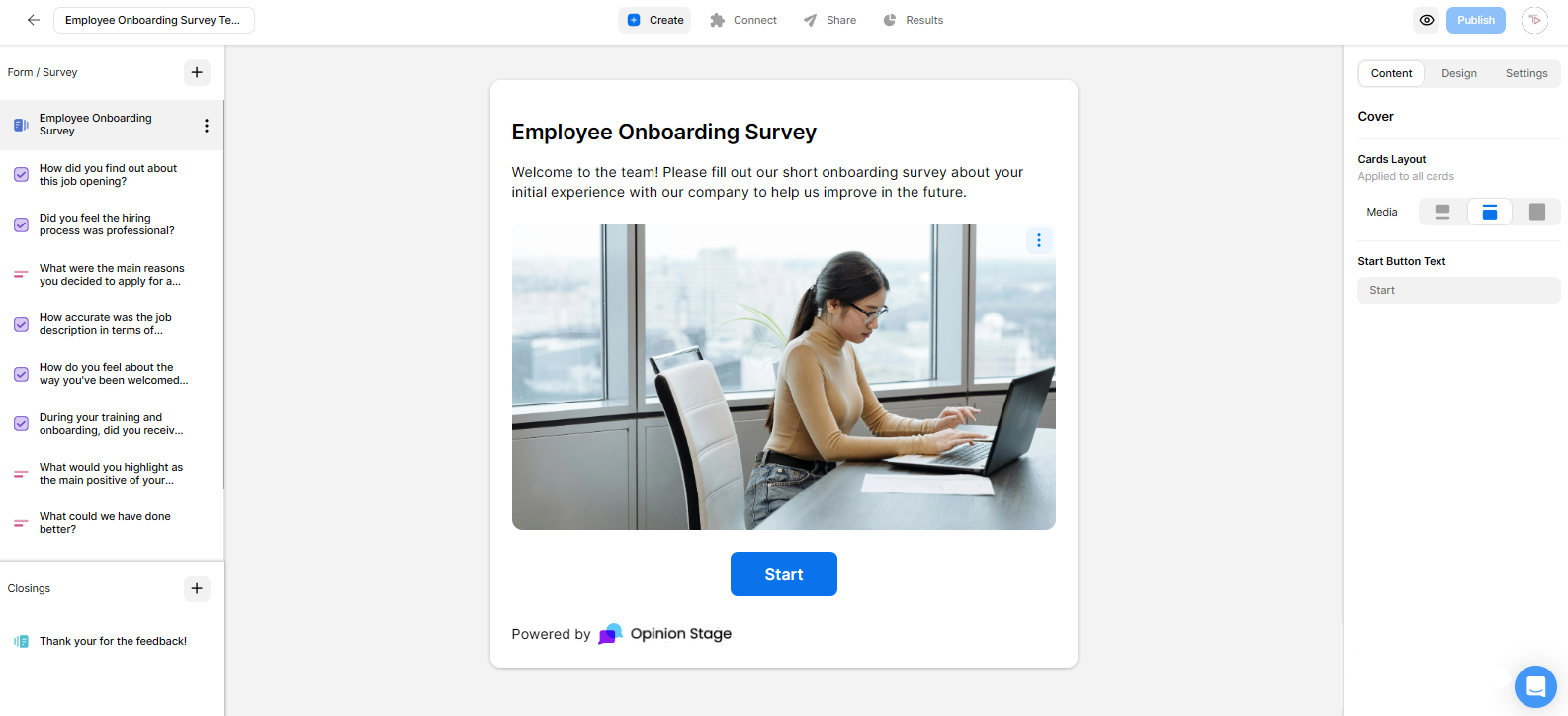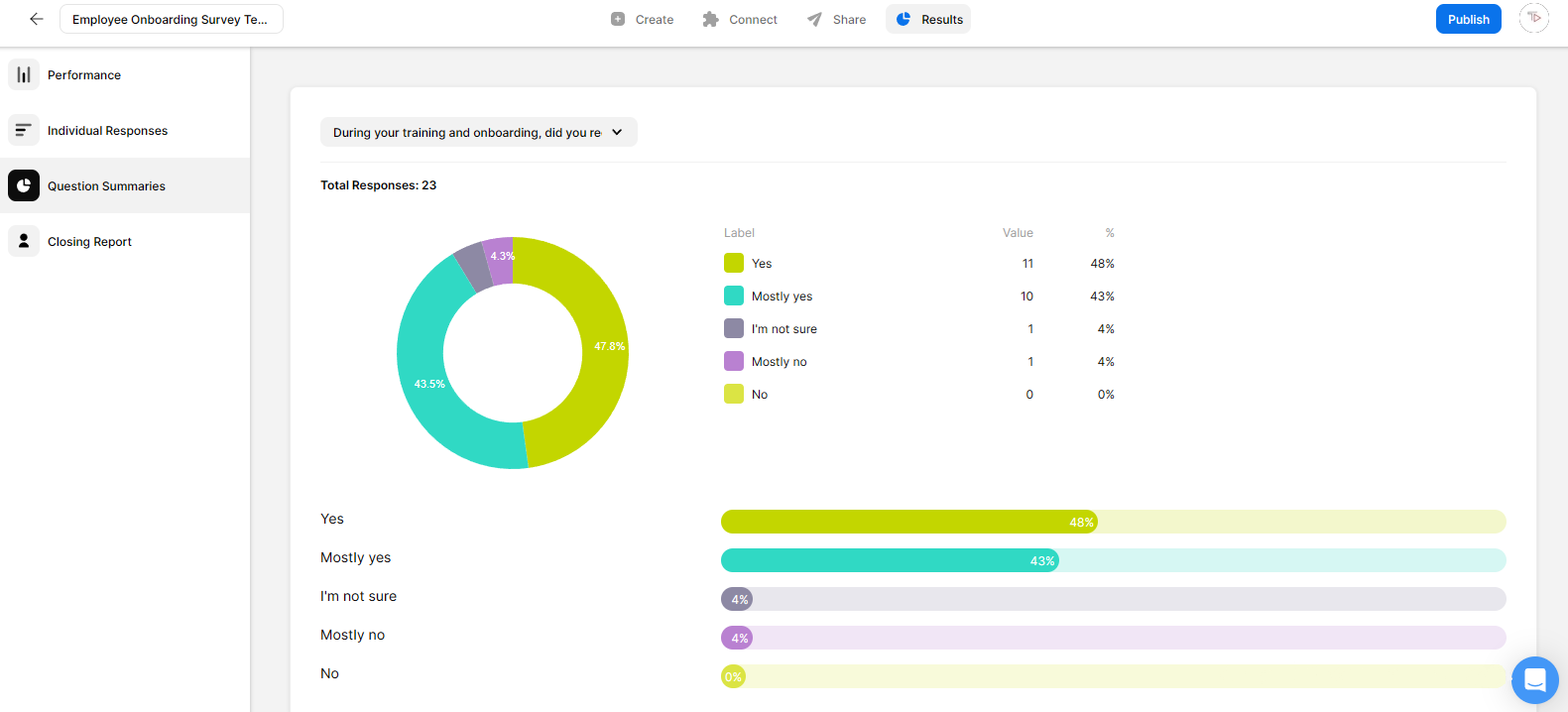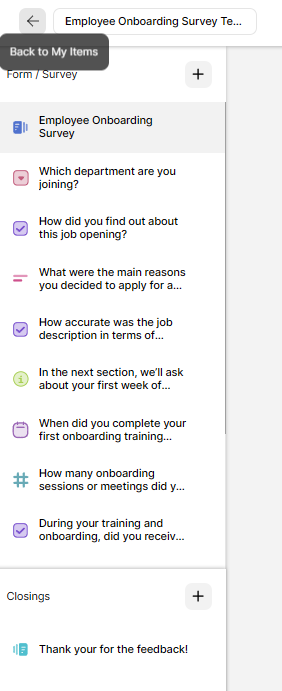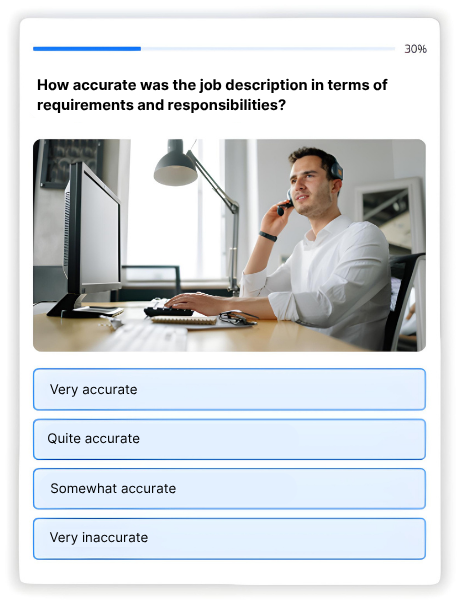75 New Hire Onboarding Survey Questions for a Successful Start
The first few weeks at a new job shape how employees feel about your company for years to come. Asking the right new hire onboarding survey questions helps you spot what’s working and what needs fixing early on.
Creating effective surveys isn’t just about collecting data. It’s about building a feedback system that transforms your onboarding from a paperwork process into a powerful retention tool that makes new team members feel valued from day one.
What is a New Hire Onboarding Survey?
A new hire onboarding survey collects feedback from recent employees about their initial experiences with your company. These surveys help identify strengths and weaknesses in your onboarding process, leading to improvements that increase employee satisfaction and retention.
New hire surveys typically cover recruitment experiences, first impressions, training quality, role clarity, and cultural integration. They can be distributed at various stages of the employee journey, from preboarding through the first 90 days and beyond.
Why Are Onboarding Surveys Important?
Effective onboarding directly impacts employee retention and productivity. When the experience is done well, it doesn’t just help new hires settle in – it sets the foundation for their long-term engagement. In fact, employees who had an effective onboarding process report 89% more engagement at work.
Onboarding surveys provide valuable insights that help organizations:
- Identify pain points: Discover where new hires struggle during their initial weeks
- Improve processes: Make data-driven decisions about onboarding improvements
- Increase engagement: Show new employees their feedback matters from day one
- Reduce turnover: Address issues before they lead to early departures
- Enhance employer brand: Create advocates who speak positively about your organization
Companies with strong onboarding programs improve retention and productivity significantly. These new hire questionnaires serve as an early warning system for potential issues that might otherwise go unnoticed until exit interviews. You can integrate surveys into your existing onboarding tools, such as an LMS for employee training, your company intranet, or even your business site, to centralize feedback and make it easier to act on quickly.
How to Create Effective New Employee Onboarding Survey Questions
1. Clarify Survey Objectives
Define specific goals for your survey before writing questions. Are you measuring satisfaction with the recruitment process? Evaluating training effectiveness? Assessing cultural integration?
Clear survey objectives help you craft targeted questions that generate actionable insights. For example, if your goal is to improve the pre-onboarding experience, focus questions on communication clarity and pre-start preparations.
2. Tailor Questions to Timelines
Different questions are appropriate at different onboarding stages. Create separate surveys for key milestones:
- Preboarding: Focus on recruitment experience and pre-start communications
- First day/week: Assess welcome experience, initial training sessions, and early impressions
- 30/60/90 days: Evaluate ongoing training, role clarity, and integration
This timeline approach captures feedback when experiences are fresh in employees’ minds and helps track the entire employee journey.
3. Include Multiple Question Types
Use a variety of question formats to gather comprehensive employee feedback:
- Likert scale: “On a scale of 1-5, how prepared did you feel on your first day?”
- Yes/No: “Did you receive all necessary equipment before starting?”
- Multiple choice: “Which onboarding resources were most helpful?”
- Open-ended questions: “What could we improve about your onboarding experience?”
An example of how you can use different question types in Opinion Stage to build a more engaging and well-rounded employee onboarding survey.
Open-ended questions tell you what you need to work on, not just that you have work to do. They provide qualitative research insights that close-ended questions cannot capture.
When you’re ready to start creating your onboarding questionnaire, choose a survey tool that supports a variety of question types and lets you combine them easily. Different formats help you capture both quantitative data, like satisfaction scores, and qualitative feedback that reveals the “why” behind employees’ answers.

An example of an employee onboarding survey created with the Opinion Stage survey maker.
4. Keep it Concise and User-Friendly
Survey fatigue is real. Limit each survey to 5-10 questions to increase survey completion rates.
Use clear, straightforward language and avoid jargon or complex terminology.
Make surveys mobile-friendly so new hires can complete them anywhere. For example, a survey built with Opinion Stage adjusts to any device, making it easy to fill out on phones, tablets, or desktops. This ensures everyone can respond in the moment, whether they’re at their desk or on the go, which can improve both completion rates and feedback quality.
5. Ensure Confidentiality
New employees may hesitate to provide honest feedback if they fear negative consequences. Clearly communicate that responses are confidential and, when possible, use anonymous surveys.
💡 Pro tip: If you’re using Opinion Stage to create your onboarding survey, it’s anonymous by default unless you choose to collect contact information. This helps build trust and encourages honest feedback, giving you clearer insights into how new hires are experiencing your onboarding process and where you can improve.
75 Essential Onboarding Survey Questions for New Hires
Preboarding and Day-one Questions
Preboarding refers to the period between when a candidate accepts an offer and their first day on the job. These questions focus on the pre-onboarding experience and first impressions:
- How would you rate the clarity of pre-start communications?
- Did you receive all the necessary information before your start date?
- Which of the following were ready for you on arrival? (Desk setup, equipment, login credentials, welcome package, none of the above)
- Did you know who to contact with questions before starting? If not, what information would have made this clearer?
- How welcoming was your first interaction with the team?
- Did you receive a clear agenda for your first day?
- Were your technology and tools ready for use?
- Did you feel prepared for your first day?
- How would you rate the onboarding materials provided before starting?
- Was your manager available to greet you on your first day?
The preboarding phase sets the tone for the entire employee onboarding process. Effective preboarding can significantly improve first-day experiences and reduce new-hire anxiety.
First-week Survey Questions
These questions assess initial training, team introductions, and early comfort level:
- How would you rate the clarity of your role expectations?
- Did you feel welcomed by your team members?
- Was your onboarding schedule well-organized?
- Which areas of training were most helpful?
- How comfortable do you feel asking questions?
- Which of these key team leaders did you meet during your first week? (provide a list of leaders to select)
- Were your initial tasks explained clearly?
- How well do you understand the company values?
- Did you receive feedback on your performance so far?
- How would you rate the manager support you’ve received?
First-week surveys capture critical feedback about orientation sessions and initial team dynamics. This feedback helps refine the employee orientation process for future hires.
30-day Onboarding Survey Questions
These questions focus on training effectiveness, role clarity, and initial integration:
- Which of the following resources do you need more of? (Training materials, software/tools, team support, policy info, other)
- How well do you understand company policies and procedures?
- Have you received adequate training for your current responsibilities?
- How confident do you feel in your role after 30 days?
- Are you clear on performance metrics?
- How often did you receive manager check-ins?
- How would you rate your integration with your team?
- Do you feel your skills are being utilized effectively?
- Are there any areas where you need additional support?
- How satisfied are you with your onboarding experience so far?
The 30-day mark is crucial for identifying knowledge gaps and addressing them before they impact job satisfaction and performance.
60-day Questions
These questions address deeper integration, feedback on management, and progress tracking:
- How would you rate your manager relationship?
- Do you feel like a valued member of your team?
- Have you received constructive feedback on your work?
- Are you clear on your development opportunities?
- How well do you understand your career path here?
- Have you built strong relationships with colleagues?
- Are you satisfied with the communication from leadership?
- Do you feel empowered to make decisions in your role?
- How would you rate the ongoing training process?
- Are there any barriers to your success at this stage?
Within 60 days, employees should feel integrated into the company culture and clear about their role.
90-day and Beyond
These questions focus on long-term satisfaction, career development, and suggestions for improvement:
- How satisfied are you with your overall onboarding experience?
- Do you see yourself staying with the company long-term?
- Have your initial expectations been met?
- How would you rate your work-life balance?
- Are you satisfied with your employee development opportunities?
- Do you feel your role aligns with your skills and interests? If not, where do you see the biggest gaps?
- How well do you understand the company’s long-term vision?
- Have you received opportunities for professional growth?
- Do you feel supported in your role?
- How likely are you to recommend the company to others?
The post-onboarding phase marks the transition to regular employee pulse surveys that track engagement throughout the employee lifecycle.
How to Interpret and Act on Onboarding Feedback Survey Results
1. Identify Recurring Themes
Look for patterns in your survey data. Are multiple employees mentioning the same challenges? Are certain departments scoring consistently lower than others?
Check your Opinion Stage analytics dashboard to start spotting patterns in your survey data. Use both quantitative data (numerical ratings) and qualitative feedback (written responses) to identify trends. Export the data to group feedback into categories like training effectiveness, manager guidance, and resource availability. This makes patterns easier to spot and helps you see where attention or improvement is most needed.

The Opinion Stage real time analytics dashboard.
2. Prioritize Improvements
Not all feedback requires immediate action. Prioritize issues based on impact, frequency, and feasibility:
- Impact: How significantly does this issue affect new hire success?
- Frequency: How many employees mentioned this concern?
- Feasibility: How easily can you implement changes?
Focus first on high-impact, quick-win improvements that will make a noticeable difference to your next cohort of new hires.
3. Communicate Findings to Stakeholders
Share survey results with relevant stakeholders while maintaining confidentiality. Create a summary of key findings and recommended actions for leadership teams.
Periodically publish feedback data on an internal platform so employees know their thoughts are meaningful. This transparency builds trust in the feedback process and creates feedback loops for continuous improvement.
4. Track Changes Over Time
Measure improvement in onboarding satisfaction across multiple cohorts of new hires. Use consistent survey questions to benchmark progress and identify trends in employee satisfaction scores.
Set specific goals for improvement and regularly review progress. Celebrate successes when metrics improve and adjust strategies when they don’t.
Additional Tips for Boosting Survey Engagement
1. Send Surveys at Optimal Intervals
Timing matters. Send surveys at regular intervals when experiences are fresh in employees’ minds. Avoid sending surveys during particularly busy periods when completion rates might suffer.
Consider automated triggers based on hire date to ensure consistent timing across all new hires. This creates a scalable survey approach that works for organizations of all sizes.
2. Use Engaging Survey Design
Craft friendly, welcoming survey introductions that explain why feedback matters. Use clear, conversational question phrasing to encourage thoughtful open-ended responses.
Visual elements like progress bars can increase completion rates by showing respondents how much of the survey remains. Survey customization options can help match your employer brand.
Example of an employee survey created with Opinion Stage, featuring a progress bar and multiple-choice question format.
3. Provide Quick Wins Based on Feedback
Act on survey results quickly and visibly. When employees see their feedback leading to real changes, they’re more likely to participate in future surveys.
Communicate improvements directly to new hires: “Based on recent feedback, we’ve updated our technology setup process to include…” This creates a positive feedback mechanism that encourages ongoing participation.
FAQs About Onboarding Surveys
You can adapt onboarding survey questions for different departments by keeping a few core questions for everyone and adding ones that fit each team’s tools, workflows, or challenges. This way, you get consistent company-wide data while still capturing what’s unique to each department.
The best way to handle multiple languages for global onboarding surveys is to use professional translation and keep cultural differences in mind. In Opinion Stage, you can also use the built-in language options (available in 40+ languages) to make your survey more accessible to global teams.
You should update your new hire onboarding survey questions once a year or any time your onboarding process changes. Keeping your questions up to date helps you collect feedback that actually reflects the current employee experience.
For employee onboarding surveys, you should aim for a response rate of around 70% to get a reliable view of your new hires’ experiences. If your rate is lower, look at when you’re sending the survey or how long it takes to complete – small changes can make a big difference in participation.
Five good survey questions for employees should focus on satisfaction, clarity, and support.
For example, you could ask:
1. How satisfied are you with your role?
2. Do you have the tools you need to succeed?
3. How supported do you feel by your manager?
4. Is communication clear within your team?
5. What improvements would make your work experience better?
In an onboarding survey, you should ask questions that measure how new hires feel about their first experiences. Include questions about role clarity, training quality, team support, and overall satisfaction with the onboarding process to learn what’s working and what needs improvement.
The 30-day survey for new hires is a short check-in that helps you understand how new employees are settling in after their first month. It typically asks about job clarity, training effectiveness, company culture, and any challenges they’ve faced so far.
Ready to create your own survey?






